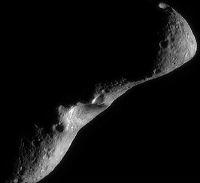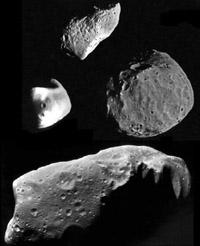Space Encounter
2000/02/15 Roa Zubia, Guillermo - Elhuyar Zientzia
Planets are born together progressively the matter that revolves around a star. Thus the solar system was born. But the process is not over. From now on, free parts will also join together to form new planets. In fact, meteorites and asteroids fallen to Earth are part of it. 65 million years ago, an asteroid fell on Earth and caused a terrible shock. This caused the dinosaurs to disappear.

In addition to the planets, the largest fragments of those remaining rotating around the sun are therefore asteroids. It is one of the largest. It is the size of a small town. 432 known asteriodes until their discovery in August 1898 moved between the orbits of Mars and Jupiter. On the contrary, Eros on each tour part of those surroundings and approaches much to the Earth's orbit. This has two types of readings.
There is a moment of concern for catastrophes, because they say that Eros' probability of colliding with Earth is about twenty. But you can see the situation in an affordable way, the view of the mission of NASA's NEAR probe.
Asteroids are halfway through the big planets. Therefore, they have often been proposed as long travel stops. On the other hand, they could be the most suitable places for the location of space gaps. Eroski also offers us this option but without going so far. It can be considered as a stop on trips to Mars. But to carry out ideas like this one must begin the first exploration. And that's the goal of the NEAR probe.
Mission
On February 17, 1996, the Near Earth Asteroid Rendezvous (NEAR) probe was launched, product of the latest technology by John Hopkins' Applied Physics Laboratory. It was the first space probe to study asteroids. This opened a new door to the investigation of the creation of the solar system. In June 1997 he passed through the asteroid Matilde.
Yesterday it entered orbit around NEAR Eros. Although initially the orbit is high (330 km), it will be progressively approaching until reaching an orbit of low height (50 km). Once approximate, NEAR will analyze the surface of the asteroid using sensors and spectrometers. The information obtained will be of great use for next steps, since in subsequent missions some ship is expected to descend to that surface. At NASA they look at the success of the current step. It is not easy to keep the orbit of such low gravity long enough to carry out research. For the moment it is there. The meeting took place yesterday at 260 million kilometers from the Earth, at 16:30 in the afternoon. We wait for you in the coming days.

Gai honi buruzko eduki gehiago
Elhuyarrek garatutako teknologia






